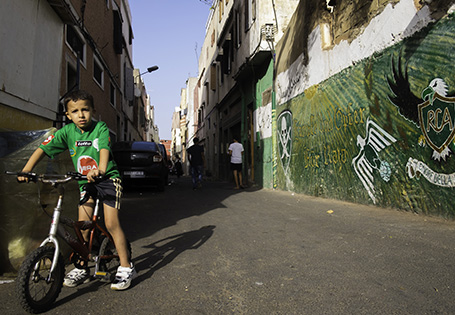… and its tales
Some cities have an extraordinary feature... they allow their visitors to revisit their history. Casablanca is no exception, as many streets, avenues, boulevards, and squares are named after dead Moroccan or foreign figures. It is a way of paying them tribute. Yet, some places have an even more unique history, full of secrets or stories, imbued with spirituality or even mysticism. If you really wish to walk in the footsteps of the people of Casablanca, you may, as you walk, wish to let yourself be charmed by the mystery of its alleys, to breathe deeply the airy blast of the legends that surround and enliven it, to approach it by the sensations rather than by the appearance of the intellect...

Sidi Abderrahmane, the first inhabitant of the small eponymous island
Read more +
Sidi Abderrahmane, the first inhabitant of the small eponymous island

Sidi Abderrahmane, the first inhabitant of the small eponymous island
In the imagination of the people of Casablanca, the island of Sidi Abderrahmane holds a special place. With a pressed or malicious smile, whispers or even frank laughter, those who talk about it cannot manage to remain composed and swear they are far from the "practices" which are said to be perpetuated since the 19th century. We just want to believe them... Rumor has it that people come from far away to slaughter black roosters there, see psychics and try this or that lucky charm to bring a man home, pass an exam, or make a competitor passive. To the extent of forgetting that originally, Sidi Abderrahmane, whose mausoleum is still on the island, was a very pious, wise, good man who came from Baghdad, and who chose to make this place his home because he loved the sea, and preferred to sleep under the open sky rather than in the house that the visitors of the island had built for him. Even today, it is possible to buy a candle at the entrance of the island and walk along the path that leads to his resting place to pay him a final tribute. It is difficult to say whether this place is truly loaded with esotericism or simply a spot for charlatans. But those who take the leap are never disappointed...
For more information, visit:
http://takamtikou.bnf.fr/bibliographies/notices/les-l-gendes-de-casablanca

Lalla Taja, the kind-hearted lady
The day will come when the neighborhood of the old medina will pay the prominent figure of Lalla Taja the tribute she deserves, having spent all her life caring for poor children and orphans. Brave, generous, and free, she was able to convince the Belgian authorities to help her in her social battle in favor of the have-nots. Yet, her death was tragic, and this untold tale deserves to be told. Under circumstances that are difficult to trace (maybe because of jealousy or due to her way of life), the young lady was stoned and died as a result of her injuries. Upon her death, because the inhabitants of the neighborhood did not want her to be buried in the Muslim cemetery, she was buried in the "house with the green door".

Lalla Beïda, the mother of Casablanca?
A persistent legend, which was possibly born around the 14th century, claims that a young lady, Lalla Beïda, gave the city its name. She was the daughter of Sidi Allal El Karouaini, the first head of the city. Legend has it she tried to join her father who had left Kerouan in Tunisia for Senegal by ship, and whose ship had capsized. The father was rescued by fishermen, but like a curse, his daughter was shipwrecked and drowned. The sanctuary that her father built for her, and where both their graves lie, still exists close to Tnaker Street in the old Medina. And who is to know what happens each time we say the words Dar el Beïda?

The old medina (Koubba Sidi Bou Smara)
The old medina is a very charming place, with a truly authentic Casablanca identity. Vivacious during the day, it is also a place of transformation. Is it because of the calm that prevails at night? Is it the sea air from the neighboring port which spurs the imagination of the residents and passersby? The fact remains that this neighborhood is home to one of the most baroque landmarks: the koubba (the mausoleum) of the Sidi Bou Smara marabou, whom almost all the children of Casablanca have heard of. Over a thousand years ago, this marabou, railing against the poor manners and lack of hospitality of some inhabitants of the old medina whom he had come to see, struck the ground with his stick… and there emerged a giant fig tree and a spring. To implore forgiveness and come under his protection, passersby and some inhabitants have ever since gotten into the habit of driving nails in this place…

Sidi Belyout Neighborhood
Even if we don't feel it right away, going for a stroll in Sidi Belyout neighborhood is like stepping into a lion's den. Indeed, the legend of a former shepherd who took his sheep to graze accompanied by a loyal lion is among the legends that are the most rooted in the imagination of the people of Casablanca. Abou Louyout (the father of the lions), as everyone called him, has some sort of influence on wild beasts that followed him as he walked, the gift of ubiquity as some said they saw him in different places at the same time. Legend has it that to no longer see the deprivation of mankind, he chose to take up exile in the Ain Sebaa forest (the spring of the lion) after having… pierced his eyes. Still today, the myth remains alive: north of the neighborhood of the old medina, the Koubba Sidi Belyout was built in the 19th century. It houses the tomb of this friend of lions and protector of the city, as well as a mysterious fountain…


























